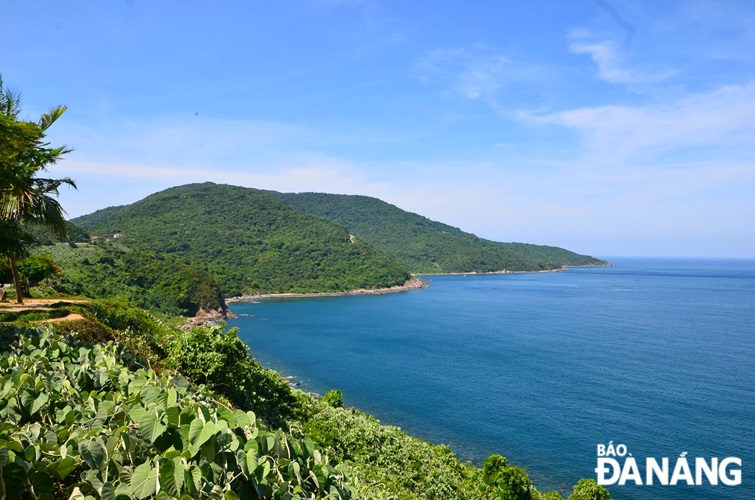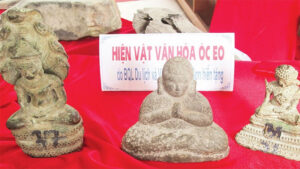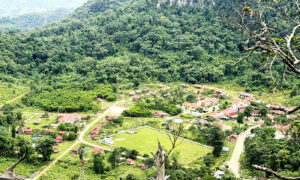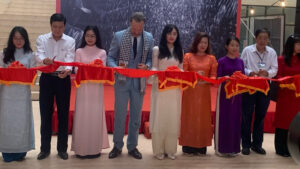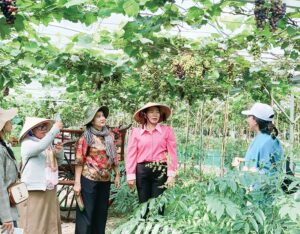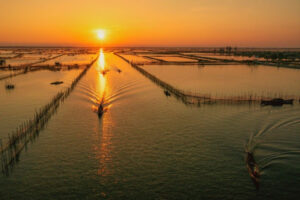“I study garden houses as a connection between Vietnamese art and culture and a deep connection with the land and spirit of Hue. Hidden cultural features still thrive in the values and identity of Hue today,” said Professor and Landscape Architect Kimberlee Stryker (University of California, Berkeley) in her “Listening to the Gardens of Hue, Vietnam” 25 years ago.
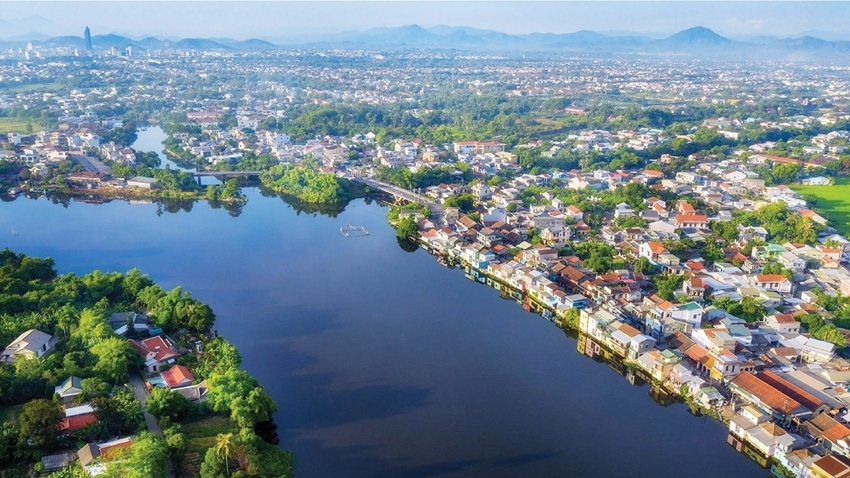
Hue is similar to an urban complex consisting of large houses and gardens. Photo: Minh Hoa
The research conducted by Prof. Kimberlee inspired a discussion titled “Listening to the Gardens of Hue,” which was held at An Nhien Garden in Hue city last weekend. The discussion marks the beginning of the 14th Vietnamese Architecture Student Festival in Hue, scheduled from April 21 to 25. The event is jointly organized by the Vietnam Association of Architects - Thua Thien Hue Association of Architects and the Faculty of Architecture at the University of Sciences, Hue University. The Festival brought together 29 architecture universities nationwide, along with landscape experts, cultural researchers, architects, garden house owners, and Hue lovers.
Combining multiple values into a more concise form
Explaining why the topic of the discussion has the word “listen” and not any other word, Asso. Prof. Nguyen Hanh Nguyen, architect, authoring the presentation “Hue Garden Landscape from an International Perspective,” believed that one can understand Hue gardens only by contemplating and listening with their senses, as they hold many values.
In her research report “Listening to the Gardens of Hue, Vietnam”, Prof. Kimberlee Stryker once wrote: “Hue, the former capital of Vietnam is widely known as the “garden” city of the country... Gardens in the Ancient Capital evoke lively poetry, wisdom, and exquisite taste that engages all the senses. This sensory characteristic distinguishes them from Western gardens. When we explore the gardens in Hue, we witness the soul and heart of Vietnamese and Hue traditions as the center of culture and art.”
Architect Hanh Nguyen stated that certain countries have distilled the characteristics of landscape elements in their traditional gardens. The French garden is characterized by its flatness, geometric design, absolute symmetry, and sense of power. The English garden encompasses both the romantic and untamed aspects of nature. The Japanese garden is a place that embodies tranquility, meditation, and minimalism... “Can the Hue Garden be considered a representative of the traditional Vietnamese garden model and be introduced to the world?” Hanh Nguyen raises.
“Perhaps our fear stems from the belief that Hue Garden lacks clarity and cohesiveness, making it difficult to be presented as a philosophical concept. Analysis, definition, and location are necessary to fully appreciate the allure of Hue's gardens, from royal gardens and tombs to those in former mandarins’ palaces. The gardens hold significant value in Hue's heritage system. Hue can completely go on to demonstrate a greater value than that: Encapsulating the philosophies of the Vietnamese outlook on life hidden in the traditional garden model,” affirmed Architect Hanh Nguyen.
Prof. Kimberlee's research indicates that Hue gardens are standard, unmixed, and typical. “I was surprised upon entering the Hue garden because every tree here is valuable and available. As you enter the Hue garden, you will hear cicadas chirping and leaves rustling, as well as the chatter of people. It is a location where the architecture, landscape, and people come together in perfect harmony,” shared Architect Hanh Nguyen.
Hue Garden, or the garden in Hue royal architecture, is a representation of Vietnamese culture that emphasizes sophistication, subtlety, and harmony with nature. Hue garden landscapes, reflecting Eastern philosophy and the Nguyen Dynasty culture, are commonly found on the grounds of ancient mansions and villas in Hue.
Architect Hanh Nguyen identified the following exceptional features of Hue's garden landscape. The Hue garden is designed to blend natural elements such as plants, water, rocks, and open space together in perfect harmony, creating a lively and peaceful environment. Although Hue gardens do not adhere to rigid symmetry, they still achieve a balance and harmony between landscape elements through a natural layout while maintaining order. Water is an important element in Hue gardens, often seen in small ponds and lakes. These bodies of water are typically decorated with lotus plants or raised fish, bringing coolness, tranquility, and liveliness to the garden. Hue Garden cultivates a diverse array of trees, ranging from fruit-bearing to ornamental species, creating a rich tapestry of colors and textures. These plants not only bring beauty to surroundings but also provide useful benefits, reflecting the close relationship between humans and nature.
Garden is the place where people sublimate with nature
During his presentation titled “Hue Garden House - A Vision from an Anthropological-Cultural Perspective,” researcher Nguyen Huu Thong pointed out that while gardens in other countries can represent the control of nature, Vietnamese gardens are designed to showcase harmony with nature. Hue Garden boasts a diverse range of plant types and a symbiotic compromise between humans, domesticated and semi-domesticated plants, and countless native wild plants. The first impression of Hue houses is the multi-layered green trees, giving a hint of forestry to those people from far away approaching them. However, the forest garden is actually a "pretend" one, with each tree type arranged according to the biological characteristics that the Hue people have summarized to settle according to each type. And he calls it the “normative in the wild” space. A garden that appears to be natural but is actually not. It appears neglected, but in reality, it is well taken care of. That is the sophistication of Hue garden.
As for Mr. Thong, Hue Garden is the product of a large family that created it together over many generations. Hue Garden is an interaction and an environment that nourishes life and art creativity and a place that makes people sublimate with nature.
Architect Nguyen Thanh Tung, M.A., Founder and CEO of ANTT Architects, presented a unique perspective on the value of Hue gardens in urban landscape architecture in his presentation titled “Garden House: A Characteristic of Hue Urban Landscape Architecture.” He believed the Hue garden house was a native architectural feature of Vietnamese people. Hue has a system of gardens, accompanying houses, buildings, palaces, pagodas, and mausoleums..., especially in the Hue Imperial City and Citadel, together with its very large garden system, having transformed it into a vast urban complex, comprising numerous houses and gardens. These elements create the “very porous” emptiness and openness, a unique characteristic of the Hue urban area. Nature is the core that shapes Hue garden houses. In other words, nature is the inspiration and core value for building Hue garden houses.
The value of Hue garden houses is so obvious. However, many landscape architects, researchers, and Hue lovers still wondered how to conserve, preserve, and promote the value of Hue garden so that it can become a typical Vietnamese garden, similar to how other countries have done with their typical gardens. It is crucial to clarify which gardens in Hue have been included in the protection list, which gardens have been designated as heritage gardens, and how to protect them. Identifying ways to incorporate Hue and Vietnamese gardens into modern and contemporary buildings is also necessary.
The discussion with the exciting topic “Listening to Hue Gardens” with shared stories and opinions has clarified the value of Hue Gardens and suggested directions for better conservation and preservation. From there, the value of Hue Garden will be brought further.
Story: Ngoc Ha



